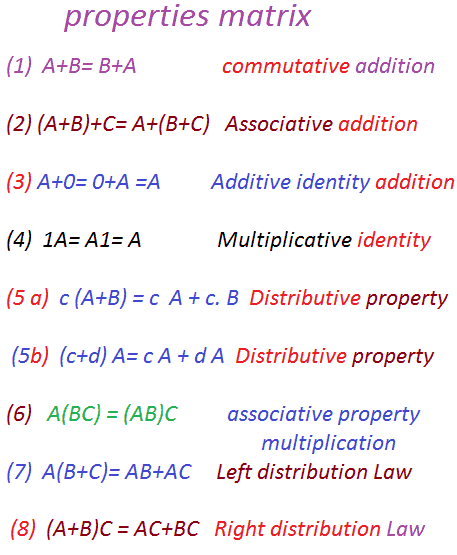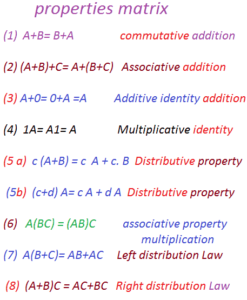If A, B, C are m × n matrix and c and d are scalars, the following properties are true.
(1) commutative property with respect to addition
A+B= B+A
(2) associative property with respect to addition
(A+B)+C= A+(B+C)
(3) associative property of scalar addition
(c d) A=c (d A) where c and d are scalar.
(4) Existence of additive identity OR null matrix
A+0= 0+A =A (where 0 is null matrix)
(5) Existence of multiplicative identity(unit/identity or imaginary matrix)
1A= A1= A
(6) Distributive property w.r.t scalar multiplication.
(a) c (A+B) = c A + c. B
(b) (c+d) A= c A + d A
(7) associative property with respect to multiplication.
A(BC) = (AB)C
(8) Left distribution Law (property)
A(B+C)= AB+AC
(9) Right distribution property
(A+B)C = AC+BC
(10) Right scalar distribution property.
c (AB) = (c A)B= A(c B)
(11) diagonal matrix properties
A diagonal matrix is called an identity matrix. If all diagonal entries are 1
EXAMPLE
EQUAL MATRIX:
any two matrices A and B are called equal matrix, if
(i) order of A = order of B
(ii) when corresponding entries are same
ADDITIVE INVERSE MATRIX:
Let A be a matrix. A matrix B is defined as an additive inverse of A. If
B+A=0= A+B
DETERMINANT OF M:
A real number (lambda) is called determinant of M, denoted by M
ADJOINT OF M MATRIX:
RELATED POST:
- TYPE OF SET
- ♣
- RELATION CONCEPT
- ♣
- FINITE AND INFINITE SET PPT
- ♣
- .55555 is areal number
- ♣
- PROPER AND IMPROPER SET
- ♣
- Straight Line parallel to the x-axis equation
- ♣
- branches of curve of hyperbola

